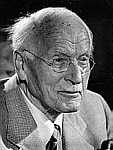Carl Gustav Jung: An
Introduction
© Dave Hiles, October
2003
| Carl Gustav JUNG (1875-1961), founder of the School of Analytical Psychology, was primarily a psychotherapist, but his theories and writings have the widest relevance to modern day psychology. Jung has attracted descriptions that range from obscure mystic to genius. Jung collaborated with Freud for only about six years (1906 -1912), and despite producing highly original work over the next fifty years, he has been overshadowed by Freud, and has particularly been ignored and largely misunderstood by academic psychology. Jung deserves better than this. His work is quite accessible. His ideas are an important forerunner of both humanistic and transpersonal psychology, and offer a major contribution to any modern day theory of the "Self", which has a central role to play in our understanding of therapeutic practice, the nature of human experience, and how we represent ourselves to ourselves. |  |
(1) CARL JUNG (1875-1961)
| 1875-1906 | Medical Training: (1895- ). Burgholzli Hospital, Zurich. MD dissertation entitled "An Occult Phenomenon". Word association experiments. Schizophrenia Research. Correspondence with Freud begins. |
| 1907-1912 | Meeting with Freud (1907). Visit to USA (1909). Elected 1st President of the International Psychoanalytic Association. Psychology of Unconscious (1912). |
| 1913-1919 | Designation of "Analytical Psychology"; resigns Presidency; period of "intense introversion"; Seven Sermons to the Dead (1916). First use of terms:- Collective Unconscious, Individuation, Persona, Anima/Animus, and Archetype. Interest in Gnosticism begins. |
| 1920-1928 | First use of the term "Self". Influence of Richard Wilhelm and I Ching (Trans: Book of Changes). |
| 1929-1961 | Alchemy and Psychology of Religion. Modern Man in Search Of A Soul (1933). Answer to Job (1952). Man and His Symbols (1964). |
(2) C. G. Jung - Major influences
G Paranormal Phenomena - viz. MD thesis, the concept of synchronicity.
G Self-Insight - see Memories, Dreams and Reflections.
G Taoism - Chinese alchemy.
G Alchemy - a medieval expression of gnosticism incorporating hermeticism.
G Gnosticism - early pre-Christian sects that emphasised self-knowledge (see Pagels, 1982).
(3) Jung's Place in Psychology:
The Four Forces in Psychology
M
1st force: PSYCHODYNAMIC
Freud,
Jung, Adler, etc. (Metaphors: depth, forces, conflict, energy, drive,
etc.)
M
2nd force: BEHAVIOURISM
Skinner,
Watson, Eysenck, etc. (Metaphors: process, mechanism, computation,
animal behaviour)
M
3rd force: HUMANISTIC-EXISTENTIAL
Maslow,
Rogers, Perls, Laing, Jung, etc. (Metaphors: growth, potential,
wholeness, self, etc.)
M
4th force: TRANSPERSONAL
Maslow,
Wilber, Grof, Jung, etc. (Metaphors: levels, health, light, god-head,
suffering, Self, etc.)
(4) C. G. Jung - Some key concepts
| collective
unconscious archetypes symbols complex structure of the psyche: persona ego shadow anima/animus Self |
Self
as an integrating principle psychological types individuation active imagination dreams synchronicity |
(5) Further Reading:
Jung, C.G. (1963) Memories, Dreams and Reflections.
Fontana.
Jung, C.G. (1964) Man and His Symbols. Aldus/Jupiter.
Robertson, R. (1992) Beginner's Guide to Jungian Psychology.
Nicholas-Hays.
Singer, J. (1995) Boundaries of the Soul: The practice of Jung's
psychology. 2nd Edition. Prism Press.
Stevens, A. (2001) Jung: A very short introduction. Oxford.
Internet Links:
You will find some useful links at:
http://psy.dmu.ac.uk/drhiles/Links.htm#Psychotherapy